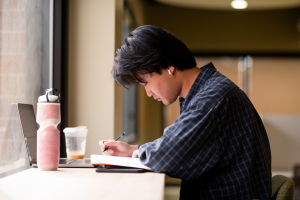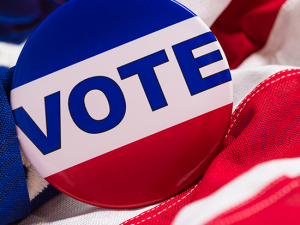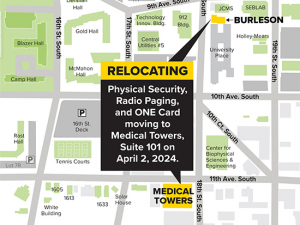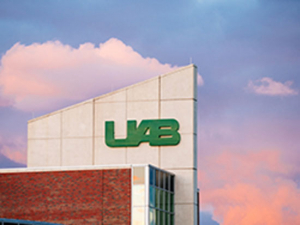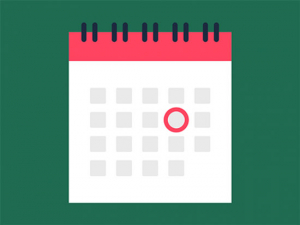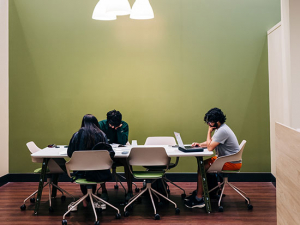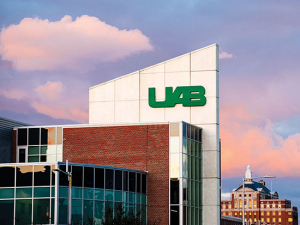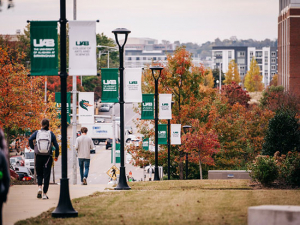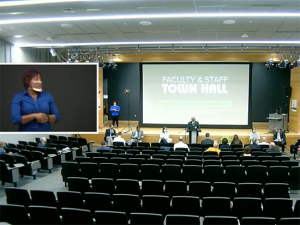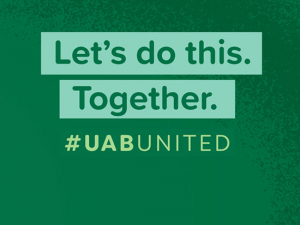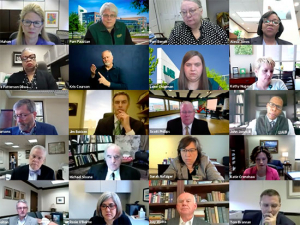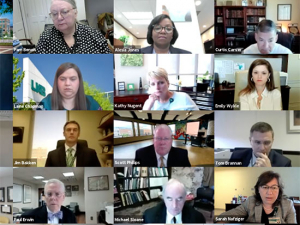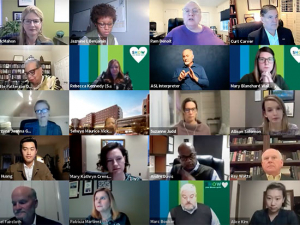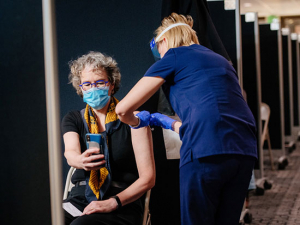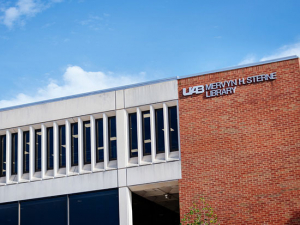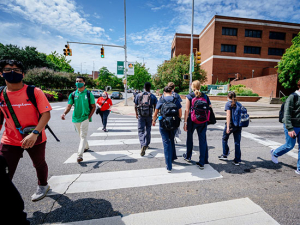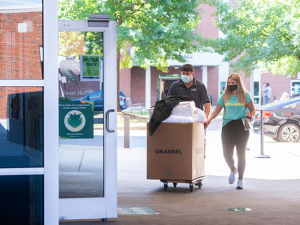In a virtual town hall with employees July 13, President Ray Watts, UAB Medicine CEO Reid Jones and other senior leaders shared plans and updates on re-entry to campus and related concerns. Employees submitted more than 170 questions and comments before and during the hour-long event, many of which the leaders answered during their remarks.
In his opening statement, Watts noted the recent surge in coronavirus cases in Alabama and at UAB Hospital. “This is an evolving situation and the virus will be with us — it’s not going away any time soon,” he said. “We want to thank you for stepping up and doing everything needed by helping us to pursue our most important and vital mission,” Watts said.
What follows is a summary of the topics covered, along with employee questions on those topics addressed by UAB leaders during the town hall.
Scroll down to read the complete summary or use the links below to jump to specific topics
UAB Medicine: Pay cuts restored, patient-volume grows, work from home
Classroom options and data dashboards
Financial update: Furloughs and FY21 budget timeline
Re-entry task forces: New Incident Command Center
Employee health accommodations
UAB Medicine: Pay cuts restored, patient-volume grows, work from home
During the past few months, the unsustainable losses that required UAB Medicine to institute pay cuts for employees have improved dramatically, said CEO Reid Jones. The hard work of employees has “brought patients back,” he said, “and we’ve received about $100 million of federal money to get us through the crisis.”
These positive developments led to this past week’s announcement that compensation would be restored, retroactive to July 1, with faculty and staff reimbursed for salary reductions between May and July 1. This applies to "everyone other than the senior staff and management team,” Jones said. “We’re going to be looking as the fiscal year unfolds at the reduction in retirement, but we won’t be able to make that decision until the end of the year.”
The number of COVID-positive patients at UAB Hospital reached 89 July 12, Jones said. “If the volumes continue to increase we will have to carefully manage that,” he said. “We’re not in the position we were in during the March and April timeframe,” however, Jones added, with new systems now in place to protect employees and patients.
Non-COVID patient volumes were nearly back to pre-pandemic levels, Jones said. “We’re seeing the ambulatory visits come back, and we’re able to get those patients the care they need.”
Finally, Jones addressed UAB Medicine employees who are working from home. “Across the country, there’s a big change in how we deploy our workforces,” Jones said. “A lot of people are able to work from home and work productively, and we hope to continue that after we return to normal operations. We want to keep you connected to our organization and your supervisors and fellow employees.”
Question submitted online:
When will UAB Medicine support staff come back to the office?
“By support staff, if you mean the people working for example in the business office and finance, we have a task force addressing exactly how we’ll return to work,” Jones said. “We want people to come in in a safe way… It’s our hope that a number of folks can work from home and we’re going to try to accommodate that as well.”
[back to topic list]
Classroom options and data dashboards
Provost Pam Benoit began by congratulating employees on their flexibility and resilience. “You’ve been anxious and stressed and that comes from working remotely and taking care of children and family members,” Benoit said. “There are a lot of stressors on you. I feel them, too, and we’re trying hard to develop plans to keep the community safe and advance the mission of the university.
“We’re in the process of completing measurements of classrooms to appropriately social distance,” Benoit continued. “We’re assigning and identifying what type of class each class that we’re offering in the fall will be. There are four possibilities: it may be in-person, or hybrid (in-person and remote activities), or fully remote or fully online.”
UAB has one of the most comprehensive health and safety programs in the country, Benoit said. That includes required mask-wearing, social-distancing, the Healthcheck to monitor symptoms, exposure notification and sentinel testing.
A new committee [the COVID Incident Command Center, see below] is monitoring the spread of COVID at UAB, in the surrounding community and regionally, Benoit said. “We’re looking to see where the cases are and where there are outbreaks.” In addition to that, UAB is identifying factors that could lead to changes in campus operations and developing dashboards to share these key metrics with senior leaders.
[back to topic list]
Sentinel and hotspot testing
Sentinel testing, which will involve random testing of roughly 4% of the on-campus employee population each week, started the week of July 6, said Anupam Agarwal, M.D., executive vice dean of the School of Medicine.
Sentinel testing, unlike re-entry testing, is voluntary, Agarwal explained. The goal is to get a snapshot of how the COVID-19 virus is circulating among the UAB population. The test uses a nasal swab, self-administered by the person being tested, with an observer making sure they did this correctly. It is not nearly as intrusive as the nasopharyngeal swabs that many people are familiar with from images of COVID-19 testing.
How it works: Randomly selected employees will receive an email on Sunday nights, with the option of being tested at one of several UAB clinics — UAB Highlands, The Kirklin Clinic, Gardendale or Hoover — on Tuesday through Thursday between 1 and 4 p.m. Turnaround time for test results to be delivered to employees is 24 to 48 hours, Agarwal said.
“If the result is positive, [the employee] gets a phone call from Employee Health and if it is negative they will get an email,” Agarwal said. This past week, 146 employees were tested, with only one positive case among that group, he said. “That was very encouraging; the [positive] person had an exposure, and we knew clearly it was going to be positive,” Agarwal said.
“We ask you to take advantage of the opportunity if you are selected in the randomization process,” Agarwal said.
A new form of testing led by Employee Health, called hotspot testing, is being introduced in UAB Hospital “and other areas where we think there may be significant risk,” Agarwal said. “The safety of employees is the most significant concern for us.”
[back to topic list]
Testing for Alabama student re-entry tests
The Testing for Alabama program, which is being led by UAB and the Alabama Department of Public Health, will enable every college student attending a public four-year and two-year college to have an opportunity to be tested prior to re-entry to campus.
“About 250,000 students will be tested 10-14 days before entry in about 15 locations across the state, with drive-through testing sites,” Agarwal said. Ideally, test results will be offered to participants within 48 hours.
[back to topic list]
Employee Health update
Sarah Nafziger, M.D., professor in the School of Medicine departments of Emergency Medicine and Neurology, and medical director for Employee Health for UAB Medicine, explained how Employee Health works with the Healthcheck COVID-19 assessment tool that all returning employees will be required to fill out at least every three days.
“If you have a positive answer [to any of the Healthcheck symptom questions], you are passed off to Employee Health and our team takes over,” Nafziger said. “We manage your testing and work restrictions related to COVID-19 and we're with you if you need hotspot testing or contact tracing on campus or UAB Medicine. Nobody likes to be sick and this situation has been tough for our employees. We all want to remain healthy. That's the top of the concern list for Employee Health.”
The good news is that the protective measures in place at UAB “seem to be effective,” Nafziger said. “If you do the masking and social-distance and you are hand-washing, they are very effective at preventing the spread of this disease.”
Questions submitted online:
If we're testing students, why are we not testing ourselves as faculty and staff as well?
“For now we're doing sentinel testing for faculty and staff,” Agarwal said. “Our hope is that by August when all faculty comes back, we'll consider offering [testing] to all faculty and staff as well.”
| This information is accurate as of publication. For the latest information on testing procedures and protocols, visit the uab.edu/coronavirus site here. |
It is important to note that “for any staff or faculty member who is symptomatic, we have a low threshold to test,” Nafziger said. “If you report any symptom close to COVID” [on the UAB Healthcheck or by contacting Employee Health], you will be considered for testing, she said. “And we have testing for high-risk exposures… directed by Employee Health at this time,” Nafziger added. “You can't just say, ‘I had an exposure and I want to test.’ It's based on risk stratification based on rules we've gotten from ADPH and the CDC and contact tracing methodology. We have a significant amount of testing going on, but it's not universal re-entry testing at this time.”
Call Employee Health at 205-934-3675 from 6:30 a.m.-5 p.m., Monday-Friday. After hours and on weekends, call the UAB Call Center at 205-934-3411 and ask them to page the needlestick/exposure nurse on-call.
I was randomly chosen to participate in the sentinel testing. It said that if I’m working remotely, I do not need to participate. Can I still volunteer for testing even if I’m working remotely?
“We're not restricting you from participating in the sentinel testing, you are welcome to,” Nafziger said. “It's not required, of course. But people working remotely, we would like for you to access Employee Health for testing if you are symptomatic as well. We want to provide those services and be there for employees whether you are on campus or working remotely.”
Can you talk about the accuracy of sentinel testing?
“The accuracy is quite high,” Agarwal said. “The false-negative rate is less than 5%. So, essentially if you have a thousand people tested, it misses 1.5 persons.” UAB is currently doing individual testing, but has now begun validating pooled testing, in which multiple samples are tested at the same time. “If one test is positive among the three, the pooled approach picks that up and necessitates us going back and testing the three individually again,” Agarwal said. “It helps us to do more testing. Right now we have manageable numbers, but if the numbers increase significantly, it allows us to [handle that] volume.”
If we have an employee test positive, are the people in their immediate area supposed to report and be tested?
“If we have an employee that tests positive, part of the process that happens after that is one of our Employee Health physicians… [will] call that person and counsel them about their health status and initiate contact tracing,” Nafziger said. “By that we mean that we'll talk to them about the exposures they've had in the workplace and the risk factors from the CDC to see if they've had high-risk exposures.
“In addition to that, we notify the supervisor of the employee to find out if there are others that have been exposed that we might need to know about.”
Each situation is different, Nafziger said. “There's no one guidance. We look at those things individually and we determine if there are individuals that need to be notified or tested based on the information that we gather.”
Can you provide clarification on how Healthcheck works?
“Healthcheck is a website that you start with and it collects basic information and periodically you check in with it,” Nafziger said. Ideally every day, but at least every three days, employees will report any high-risk exposures and any symptoms of COVID-19 through the Healthcheck site. ”If you check yes to any one of those [exposure or symptom questions], you are referred to Employee Health and our portal of entry for Employee Health.”
Note that the symptoms that are of interest are new or different symptoms, Nafziger said. If you have a pain in your back that’s always there and you check “yes” to the question on muscle pain, “it flags you for work restrictions because that is a COVID symptom,” Nafziger said. Healthcheck "is asking you for new symptoms, something that's new or different for you.”
If you report a symptom or exposure, you will be sent to Employee Health’s portal of entry, which is “a separate database and computer system,” Nafziger said. “One central tenet is we're doing all we can to protect your privacy as an employee. We are managing your private personal data and taking care of your individual health. That's why it goes into a separate system for that reason. At that point in time, we'll gather more information and see if testing is indicated and you are referred for scheduling for testing at that point.”
What if you don’t fill out the Healthcheck?
“You are required to fill out Healthcheck every three days, and you'll be alerted by email every three days asking you to respond,” Nafziger said. After six days, there will be no further reminders.
“At day 7, it comes to HR and then we start managing it as an HR issue from the standpoint of noncompliance with Healthcheck,” said Chief Human Resources Officer Alesia Jones. “What I will also remind everyone that there is a COVID awareness training that everyone who is either on-site working or will return to campus in one of the re-entry phases, will have access to.” Once an employee has completed the awareness training they will be taken to Healthcheck to begin reporting symptoms and exposures. “That's one of the ways that we monitor the training that's been completed,” Jones said.
At the department and unit level, an HR database notes all faculty and staff members and whether they have been assigned to work onsite, work remotely or work in some hybrid fashion, Jones said. “It also tracks their building location. That information is critically important to keep up to date because… if someone tests positive, you'll know who else is in that location.”
One more point on the Healthcheck, Benoit said: “It’s easier to do it daily. You are required to do it every three days. But if you have a change in symptoms, go ahead and report that before the three-day period is up.”
“It’s really easy to find Healthcheck if you have the UAB App downloaded on your phone,” said Lori McMahon, Ph.D., dean of the Graduate School and chair of the Campus Re-entry Implementation Team. “There's a tile for UAB Healthcheck. All you have to do is hit the tile and it takes you right there.”
What is the timeframe during which employees will be notified if they've been exposed to a case by a fellow employee?
If there is a high-risk exposure, “you'll probably be personally contacted by Employee Health, but possibly through a supervisor instead,” Nafziger said. “When an employee tests positive, the supervisor is notified. If there are no high-risk exposures identified, then other employees will not be notified of that positive test.”
[back to topic list]
Financial update – furloughs end July 31, budget timeline for FY2021
Allen Bolton, senior vice president for finance and administration, shared the latest on the financial status of the university.
“We’ve had a mix of pleasant and unpleasant changes” since the budget outlook was revised in response to the effects of the COVID-19 pandemic in April, Bolton said. Summer enrollment and federal CARES funding to the Health System were stronger than predicted, while budgeted income and CARES funding to campus were weaker than predicted.
Furloughs end July 31
The hiring freeze, suspension of nonessential travel and expense reductions instituted to close the budget gap created by COVID-19 are working, Bolton said. “That means that the institutional furlough plan that impacted 328 employees will end as planned on July 31.”
Budget timeline for FY2021
The campus budgeting process for the 2021 fiscal year is on a delayed schedule due to the need for updated projections on enrollment and research funding. “This week, we’ll push information out to the campus units,” Bolton said. “Central units need to submit budgets by July 24 and schools by Aug. 8. Those dates have not been posted yet; you are hearing it here first.” Individual schools may establish earlier deadlines to roll their budgets up.
The current outlook for fiscal 2021 is essentially a flat budget, Bolton continued. “I consider this to be good news in the midst of a pandemic.” The cost of preparing and maintaining COVID safety precautions on campus “is a significant new cost for the university,” he said. “This means that we’ll carry forward many of our existing expense-reduction strategies, such as suspension of nonessential travel and the hiring freeze and other unit operating-level expense-reductions. We’re not planning for a merit increase in next year’s budget as well.”
Questions submitted online:
What about merit raises where the increase has been built into the grant budget?
“We are not planning to proceed with a merit plan for the university in the upcoming budget year,” Bolton said.
When do we anticipate employees returning to work [on campus] five days a week?
This is still to be determined, Bolton said. “Dr. McMahon’s task force (see below) and the Incident Command Center (see below) are helping us to develop the data that we’ll monitor. We’re having a good amount of success with remote working and we’re pleased for that to continue.”
Each unit has been asked to develop its own re-entry plan and timeline of when employees will return. “It may be that is an alternating schedule and not five days a week,” Bolton said. “You can talk to your supervisor about the plan for your particular unit.”
How does the hiring freeze affect work-study students and will we not be able to hire new students?
The hiring suspension does not affect student work-studies or student employees, Chief Human Resources Officer Alesia Jones said.
Many students count on work study to help support themselves, McMahon added. “And we have many ideas for work-study students where they can help us to manage re-entry and working with classrooms and things like that.”
Will UAB ever address hazard pay for employees like Jefferson County has done?
“We're not looking at hazard pay,” UAB Medicine CEO Jones responded. “We're basically trying to keep up with the market and trying to appropriately recruit and retain employees.” The same is true for the UAB campus as well, Bolton added.
[back to topic list]
Parking
Several questions submitted prior to the town hall asked whether UAB would reimburse parking rates for people working remotely, Bolton said. But “parking and transportation are a core part of the university infrastructure and the majority of cost for parking is fixed,” including land, technology and safety expenses for the lots, he noted. “Therefore we don't have plans to reimburse monthly parking assessments for employees that continue to receive a paycheck.” Employees who were furloughed were not assessed for parking during their time away without pay, Bolton said.
Questions submitted online:
How will parking be handled in terms of lots now shared with UAB Medicine as UAB campus employees return to work?
“We’ve started converting some of our decks back” to the pre-COVID situation, said André Davis, director of UAB Transportation. “We’ve converted the Kirklin Clinic deck and Fifth Avenue deck and Administration Building deck, among others. We're evaluating other decks, and we'll slowly transfer them back to normal and we'll let the permit holders know about the progress.”
When will the 19th Street deck return to being for those parkers only?
“We're monitoring and analyzing that deck,” Davis said. “It's temporarily being used by UAB Medicine employees as well [as campus employees]. “We've had no capacity issues to date. We want to address it prior to getting to the capacity issues, but right now we're okay.”
[back to topic list]
Re-entry task forces — new COVID Incident Command Center
There are two task forces “working tirelessly” on re-entry procedures, Bolton said.
- The Campus Re-entry Implementation Team is chaired by Lori McMahon, Ph.D., dean of the Graduate School.
- The new COVID Incident Command Center team is chaired by UAB Chief Risk and Compliance Officer Katie Crenshaw, J.D. Its charge includes “monitoring how safely we’re re-entering and recalibrating campus data to influence our decisions and practices,” Bolton said.
Questions submitted online:
What are the parameters to decide if the fall semester will be held on campus?
UAB’s Incident Command committee “is monitoring data in the community and on campus in terms of our effectiveness and implementing all of the strategies that you hear today to promote health and safety on campus,” said chair Katie Crenshaw, J.D. “That information is going to senior leadership to pace return and approve operational plans.” There is not a single specific metric that the committee will point to. Instead, “we're looking at the total circumstances to advise senior leadership,” Crenshaw said.
“I’ll add that the hybrid teaching model will allow us to change direction if needed,” Benoit said. “That was a decision-making point when we decided to introduce the hybrid teaching model. Many of the courses [that will be offered in fall] are in that model and we can pivot and go fully remote should that need arise.”
[back to topic list]
Masks
Questions submitted online:
What access will faculty, students and staff have to PPE?
- Faculty will receive two cloth masks and two face shields as part of a welcome-back bag that also will include disposable masks that faculty can give to students who may arrive in class without a face covering.
- Students and employees will receive two cloth masks on re-entry.
UAB Facilities also will provide more than 100 bulk hand sanitizer refill stations at which employees may refill personal bottles of hand sanitizer.
Lori McMahon noted that the Campus Re-entry Implementation Team is working to determine the distribution plan for masks. Bartow Arena is one location being considered as a staging point, McMahon said.
When will masks be available for people already working on campus?
“The large order of masks is scheduled to be delivered before Aug. 1, and then we'll distribute those,” said Chief Financial Officer Stephanie Mullins. As departments have been working through their individual re-entry programs, they have been working with Procurement to obtain masks as well, she added. Any units that need to order masks should contact Mullins (by email or phone at 205-934-5121) “and we'll get you to the right area to find out if we can help you get some masks,” she said.
Do you know if UAB is accepting donations of homemade cloth masks?
Volunteer Services has been the reception point for donated cloth masks since April, noted Joan Watkins, volunteer coordinator for UAB Medicine. “We have received 37,575 masks to date and distributed 11,880 through Guest Services for guests at the screening entry points,” she said. “Many of these have been made by UAB volunteers.”
Donations are received at the 19th Street entrance to the Spain Wallace Building. Call Volunteer Services at 205-934-4270 to set a time for drop off; a staff member meets the donor at the drive-under awning so there is no need to park or enter the building.
Vice President for Advancement Tom Brannan noted that a fund to support PPE for UAB caregivers is one of several COVID-related funds that have attracted “support from our campus community, employees and students and also the City of Birmingham and beyond.” These include a student support fund and a research fund, Brannan said. Learn more and donate at uab.edu/fightcovid19/give.
[back to topic list]
Employee health accommodations
Questions submitted online:
What precautions and options are available for employees who are at higher risk for contracting the virus?
Employees with health risks related to COVID-19 should work with UAB’s AWARE disability management program. “There is a process as you go through the re-entry training where you can request accommodation, and if you need accommodation after you have completed the training you can request it through the HR website,” said Chief Human Resources Officer Alesia Jones.
How long does the AWARE process take? “It depends on the situation,” Jones said. If there is a need to gather medical data or have documentation submitted from a physician, “it may take longer than those that can be addressed without that type of information.”
The AWARE program has always maintained the privacy of employees in compliance with all of the regulatory requirements of safety and security of the data, Jones said.
Can employees take FMLA for family-related COVID issues?
“If they are approved through the process that exists, yes,” Jones said.
[back to topic list]
Diversity at UAB
Several employees asked questions related to diversity, including:
How can we get white co-workers to know that their Black co-workers are deeply hurting?
The Office of Diversity, Equity and Inclusion has been working hard to organize a series of webinars on diversity that will begin in the fall, said Paulette Patterson Dilworth, Ph.D., vice president for Diversity, Equity and Inclusion. “One of the themes that will run throughout are questions about race and racism,” Dilworth said. “We want our employees to be engaged around these issues and to feel comfortable doing so.”
DEI also has started two reading groups based around the book “Why Are All the Black Kids Sitting Together in the Cafeteria?” to begin dialogue, Dilworth said.
“UAB is well situated to address these issues and we're ahead of the game with the programming that we've done in the past and that we'll continue to do,” she said. “I would encourage you to reach out to us to make suggestions about programming or activities or speakers you would like to hear that you think might help us to elevate the conversations and the voices of all of our people.”
What is UAB doing to address pay disparities in the realm of race?
“We have not studied pay disparities to determine where they exist and [if they are] concentrated in certain areas or certain job classifications or parts of campus,” said Chief Human Resources Officer Alesia Jones. “That would have to happen to determine where they exist and then develop plans on how they would be addressed.”
[back to topic list]
Other questions
Will UAB have adequate accommodations for students who need internet access if they don’t have a place at home?
UAB was at the forefront of providing internet access to students by “opening parking lots for students to do drive-in WiFi,” said Curtis Carver, Ph.D., vice president for Information Technology. “We’re looking at doing more of that and we’re looking at statewide drive-in WiFi” through a task force appointed by Governor Kay Ivey, he added. Carver and UAB telemedicine director Eric Wallace, M.D., are both members of this task force. UAB also is partnering with the City of Birmingham and Jefferson County to identify public libraries and parks that can be used for students who are off campus.
“On campus we have the fastest network in the state,” Carver said. “We’re trying to enhance bandwidth for students to have a place to come on campus and be in a safe environment.”
Will units be able to invite people from outside campus for public presentations this fall?
“We're limiting outside visitors to our campus in an effort to keep everyone safe,” McMahon said. “Many programs have been delivering seminars through Zoom meetings, and we're suggesting that that continues for the fall. It provides opportunities for students and faculty to engage outside researchers and scholars in a safe way.”
[back to topic list]
Benoit concluded the town hall by thanking employees “for everything that you've done,” she said. “We know you are working hard to make sure that we accomplish our mission. And you can see from all the planning we’ve discussed today that we're working hard to keep you safe.”
“I hope that this openness and transparency is helpful,” Watts said. “The more you know, the better we can work together for a safe campus. The questions that may not have been addressed will be addressed and put on the [Reporter] website in the near future.”
There are still uncertainties, Watts concluded. “But we have to make plans as though we are going to bring our students back as of Aug. 24 to start classes,” he said. “There is a lot of infection out there. We are watching it very carefully and we will put all that in the decision-making process. In the meantime, thank you for all you are doing. It has made all of us proud.”
